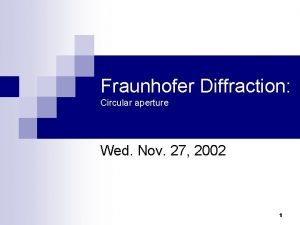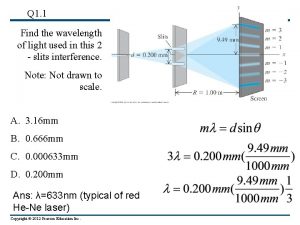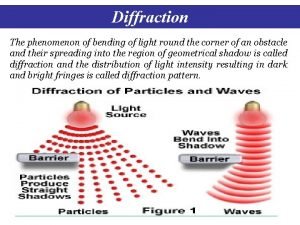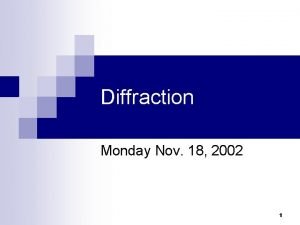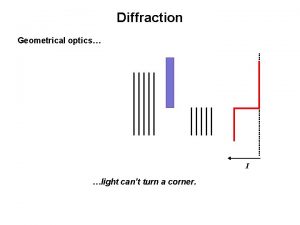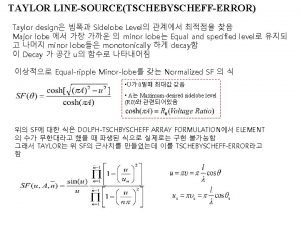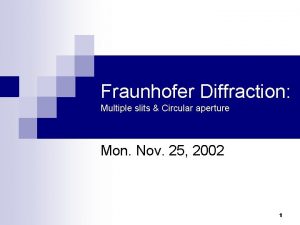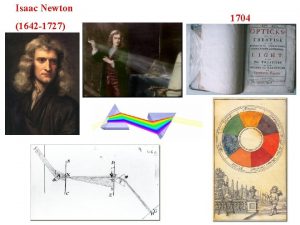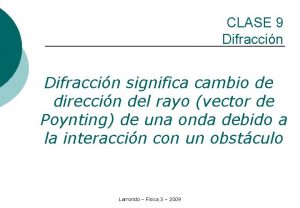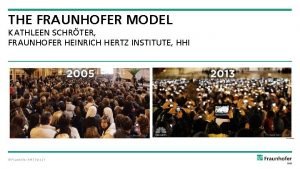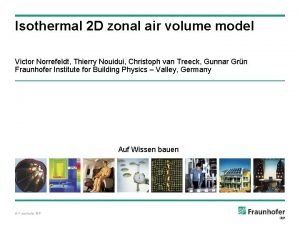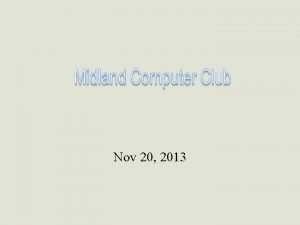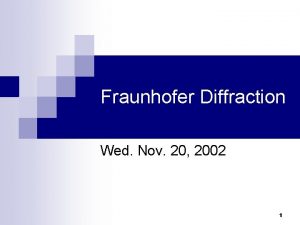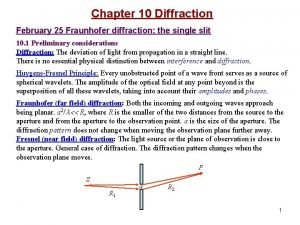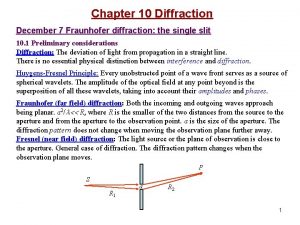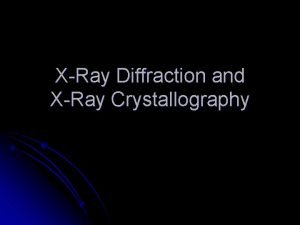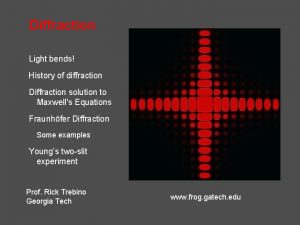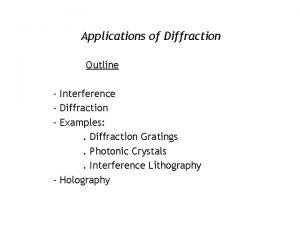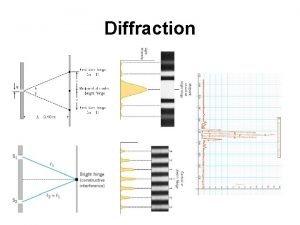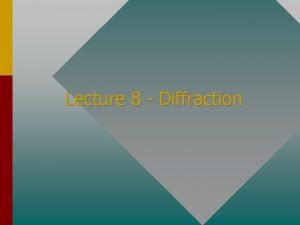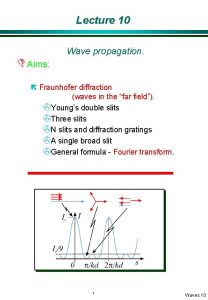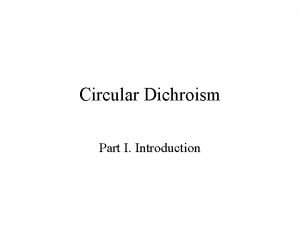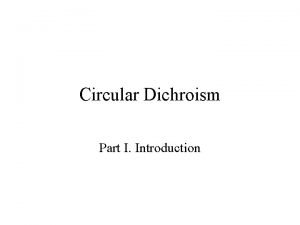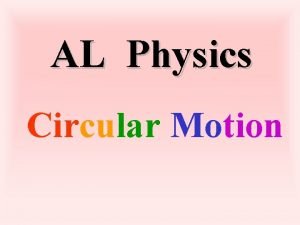Fraunhofer Diffraction Circular aperture Wed Nov 27 2002






















- Slides: 22

Fraunhofer Diffraction: Circular aperture Wed. Nov. 27, 2002 1

Fraunhofer diffraction from a circular aperture y x P r Lens plane 2

Fraunhofer diffraction from a circular aperture Do x first – looking down Path length is the same for all rays = ro Why? 3

Fraunhofer diffraction from a circular aperture Do integration along y – looking from the side P +R y=0 -R ro r = ro - ysin 4

Fraunhofer diffraction from a circular aperture Let Then 5

Fraunhofer diffraction from a circular aperture The integral where J 1( ) is the first order Bessell function of the first kind. 6

Fraunhofer diffraction from a circular aperture n These Bessell functions can be represented as polynomials: n and in particular (for p = 1), 7

Fraunhofer diffraction from a circular aperture n Thus, n where = k. Rsin and Io is the intensity when =0 8

Fraunhofer diffraction from a circular aperture n Now the zeros of J 1( ) occur at, = 0, 3. 832, 7. 016, 10. 173, … = 0, 1. 22 , 2. 23 , 3. 24 , … =k. R sin = (2 / ) sin • Thus zero at sin = 1. 22 /D, 2. 23 /D, 3. 24 /D, … 9

Fraunhofer diffraction from a circular aperture The central Airy disc contains 85% of the light 10

Fraunhofer diffraction from a circular aperture D sin = 1. 22 /D 11

Diffraction limited focussing n n sin = 1. 22 /D The width of the Airy disc W = 2 fsin 2 f = 2 f(1. 22 /D) = 2. 4 f /D W = 2. 4(f#) > f# > 1 n Cannot focus any wave to spot with dimensions < f D 12

Fraunhofer diffraction and spatial resolution n Suppose two point sources or objects are far away (e. g. two stars) Imaged with some optical system Two Airy patterns ¨ S 1 If S 1, S 2 are too close together the Airy patterns will overlap and become indistinguishable S 2 13

Fraunhofer diffraction and spatial resolution n Assume S 1, S 2 can just be resolved when maximum of one pattern just falls on minimum (first) of the other Then the angular separation at lens, n e. g. telescope D = 10 cm = 500 X 10 -7 cm n e. g. eye D ~ 1 mm min = 5 X 10 -4 rad n 14

Polarization 15

Matrix treatment of polarization y Ey n Ex x Consider a light ray with an instantaneous Evector as shown 16

Matrix treatment of polarization n Combining the components n The terms in brackets represents the complex amplitude of the plane wave 17

Jones Vectors n The state of polarization of light is determined by the relative amplitudes (Eox, Eoy) and, ¨ the relative phases ( = y - x ) of these components ¨ n The complex amplitude is written as a twoelement matrix, the Jones vector 18

Jones vector: Horizontally polarized light n n The electric field oscillations are only along the x-axis The Jones vector is then written, The arrows indicate the sense of movement as the beam approaches you y x where we have set the phase x = 0, for convenience The normalized form is 19

The electric field. Vertically polarized light Jones vector: n n oscillations are only along the y-axis The Jones vector is then written, y x n Where we have set the phase y = 0, for convenience The normalized form is 20

Jones vector: Linearly polarized light at an arbitrary angle n n If the phases are such that = m for m = 0, 1, 2, 3, … Then we must have, y x and the Jones vector is simply a line inclined at an angle = tan-1(Eoy/Eox) since we can write The normalized form is 21

Jones vector and polarization y Eoy n b In general, the Jones vector for the arbitrary case a x is an ellipse Eox 22
 Fraunhofer diffraction pattern circular aperture
Fraunhofer diffraction pattern circular aperture Fresnel and fraunhofer diffraction difference
Fresnel and fraunhofer diffraction difference Missing order in diffraction
Missing order in diffraction Fraunhofer and fresnel diffraction
Fraunhofer and fresnel diffraction Huygens
Huygens Tschebyscheff
Tschebyscheff L
L Fraunhofer
Fraunhofer Fraunhofer
Fraunhofer Fraunhofer
Fraunhofer Mathias rauch fraunhofer
Mathias rauch fraunhofer Fraunhofer
Fraunhofer Fraunhofer institute for cell therapy and immunology
Fraunhofer institute for cell therapy and immunology Fraunhofer
Fraunhofer Fraunhofer
Fraunhofer Joseph von fraunhofer
Joseph von fraunhofer Fraunhöfer
Fraunhöfer Fraunhofer
Fraunhofer Fraunhofer heinrich hertz institute
Fraunhofer heinrich hertz institute Fraunhofer
Fraunhofer Nov 19 1863
Nov 19 1863 Palabras que empiezan con nav nov pav
Palabras que empiezan con nav nov pav Ismi birləşmələr
Ismi birləşmələr
